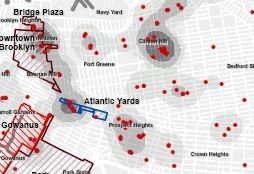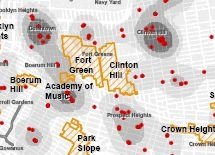 The pressure on development in Prospect Heights, cited yesterday in discussing the proposed Prospect Heights Historic District, is made clear in some new maps produced by the Municipal Art Society (MAS), which track demolition permits issued in 2006.
The pressure on development in Prospect Heights, cited yesterday in discussing the proposed Prospect Heights Historic District, is made clear in some new maps produced by the Municipal Art Society (MAS), which track demolition permits issued in 2006.One map (excerpt at right) charts the permits against recent rezonings. The darker the shading, the more intense the number of demolition permits. Clearly, there are strong trends toward demolition and new construction in eastern Prospect Heights and western Crown Heights, notably around the Washington Avenue corridor just east of the Atlantic Yards site.
(The cluster of demolitions in the western segment of the Atlantic Yards site likely had much to do with demolitions conducted by Forest City Ratner. The Atlantic Yards site, in blue, is not a rezoning but a state development plan.)
 Demolition and displacement
Demolition and displacementWhile MAS points to the "flood of development" around Brooklyn in general, a focus on Prospect Heights is illuminating. That demolitions reflect new developments reported last year and it also suggests why Prospect Heights is such a hot neighborhood.
As I reported, Brooklyn College sociologist Aviva Zeltzer-Zubida suggested that gentrification proceeds where there's a strong socieconomic difference between census tracts. That's evident in the map at right, notably the circled red-orange segment, which I eyeballed as between Atlantic Avenue and Bergen Street, and Vanderbilt and Grand avenues. (Grand is just east of Washington.)
Historic districts
 A similar map from the MAS uses not rezonings but historic districts as the backdrop. The historic districts, obviously, must remain intact, and there's been very little activity in the part of Prospect Heights listed on the State and National Registers--a prelude to local landmarking, which would offer more stringent protections. The rezonings have, in the case of Park Slope, protected interior streets while allowing new development along Fourth Avenue.
A similar map from the MAS uses not rezonings but historic districts as the backdrop. The historic districts, obviously, must remain intact, and there's been very little activity in the part of Prospect Heights listed on the State and National Registers--a prelude to local landmarking, which would offer more stringent protections. The rezonings have, in the case of Park Slope, protected interior streets while allowing new development along Fourth Avenue.For Prospect Heights, the issue cuts in multiple ways. There are strong arguments for creating a historic district protected by the Landmarks Preservation Commission. And there are arguments for more development, in unprotected areas, to accommodate growth.
The flood of market-rate development suggests that the city should have reformed the 421-a subsidy program, scheduled for revision by the state legislature at the end of the year, to stop subsidizing luxury housing in hot neighborhoods. And the general push for development again raises questions about the statement in the Atlantic Yards Final Environmental Impact Statement that the Atlantic Yards site would likely remain unchanged without the new project.
The borough, and code violations
 At right, the MAS map for Brooklyn with demolitions and rezonings. Click to enlarge.
At right, the MAS map for Brooklyn with demolitions and rezonings. Click to enlarge.Yesterday's Times brought the news the the city aims to gain new powers to revamp buildings with significant code violations and force landlords to pay the tab. Interestingly, an association of owners also supports the bill, figuring it will affect only the bad apples.
The article quoted City Council Member Letitia James, whose district includes Prospect Heights:
Referring to two large and troubled apartment complexes in her district, she said, “Elevators don’t work, rats run rampant,” and she described “mold in apartments, roofs that leak, windows that don’t work, ceilings that are collapsing.”
She said that tenants are unable to move out because they want to remain in the area and cannot find other apartments they can afford.
“It’s willful and intentional negligence,” Ms. James said. “These landlords want tenants to move. They recognize the housing market, they recognize that gentrification is spreading across Brooklyn and they want to capture the market. It’s like displacement by neglect.”
Comments
Post a Comment